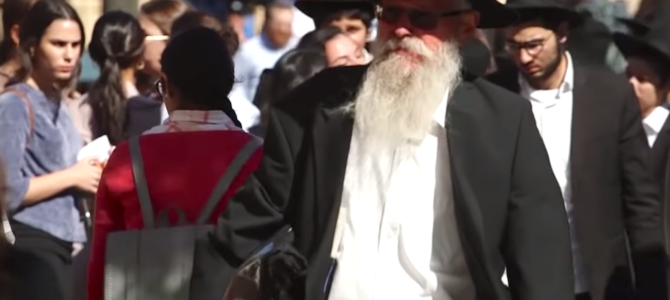
Sometimes even a publication you’ve long admired gets things horribly wrong. In this case, it’s National Review, which just published an incredibly problematic article, “Anti-Semitic Attacks Shine Spotlight on Long-Simmering Tri-State Tensions,” written by Zachary Evans, attempts to explain rising antisemitism in the New York area.
It’s a question demanding answers, especially in light of December’s antisemitic attacks in Jersey City, which left three dead at a kosher grocery, and in Monsey, which left four injured and one man facing permanent brain damage and partial paralysis. Instead of contributing to a greater understanding of the issues at hand, however, the article dives deep into the “communal tensions” narrative that both David Harsanyi (writing for National Review) and I have criticized for its fundamental victim-blaming.
Community ‘Tensions’ Didn’t Cause Antisemitic Attacks
The notion that “tensions have existed for decades in the Jewish enclaves that surround New York City” is a non-sequitur if we’re trying to understand what happened in Jersey City and Monsey. No news report has described Jersey City attackers Francine Graham and David Anderson as neighborhood residents. The idea that they experienced long-simmering “tensions” with the yeshiva children they’d initially planned to attack, or with the couple at the kosher grocery store they actually attacked, makes zero sense. This narrative also glosses over the insane idea that murder would be a rational way to handle neighborly disputes.
Grafton Thomas, who attacked the Hanukkah gathering in Monsey with an 18-inch machete, was likewise not a neighbor. The National Review article describes Thomas as a Crown Heights native, neglecting to mention he’s more recently resided “in Greenwood Lake, New York, which is about 20 miles away from Monsey.” In other words, Thomas — like Graham and Anderson — had to go out of his way to attack Jews, who were minding their own business.
As for the “outmigration from New York City” referenced in National Review’s article, Monsey is not a new center of observant Jewish life. That Jewish community has been there for decades, but even if it hadn’t been, that shouldn’t matter. Americans should be able to move without strangers second-guessing their housing decisions.
Reporters Need to Check Facts on Ad Hominem Attacks
Then, of course, there’s the anonymous allegation in the article that Hasidim are like “locusts, who go from community to community … just stripping all the resources out of it.” The anonymous interviewee, described as a “Jewish, but not ultra-Orthodox, resident of upstate New York,” sounds shockingly unfamiliar with the history of insect analogies used to dehumanize Jews. Those include Georgia Rep. Hank Johnson comparing some Jewish Israelis to termites in 2016, and U.S. Nation of Islam leader Louis Farrakhan tweeting, “I’m not an anti-Semite. I’m anti-Termite” in 2018.
In a follow-up article, Evans notes that including this grotesque comparison “obviously does not constitute an endorsement of its language or its argument,” but for that to be “obvious,” there must be a sharp rhetorical divide between this interviewee and the rest of the article. There is not.
Consider the uncritical comment about “the perception that many of the men either don’t work or make low salaries, choosing instead to devote their time to studying religious texts.” The Orthodox Jewish Public Affairs Council (OJPAC) found that “69.9% of males age 20-64 in Kiryas Joel [another heavily Hasidic area north of New York City] were employed during the 2013-2017 Census survey years. This tracks closely with the 75.8% males across New York in the same age group that were employed.”
While this data is not specific to Monsey’s Hasidim, it illustrates why “the perception” that Hasidic men don’t work is false. And as OJPAC has also noted, this narrative of Hasidim as a financial burden is swiftly contradicted by the many articles blasting Hasidic Jews as wealthy gentrifiers in Brooklyn and Jersey City.
Stop Blaming Jews for Antisemitism
All these criticisms of New York’s Hasidim, and Jews more broadly, underscore that antisemitism is fundamentally illogical. Depending on the speaker, Jews are told to “go back to” New York or Israel or Poland — where most Jews never lived. Jews are regularly criticized as both communists and capitalists. Jews are called both white supremacists and the authors of white genocide. The only through line is projection, revealing more about the bigots hurling these insults than about Jews.
If the goal of publishing Evans’s article was to better inform or even fight antisemitism, it was not helpful. When vulnerable minority groups are physically attacked, mainstream — as in non-extremist — publications typically excoriate the attackers. However, too many articles about antisemitism, including this one from National Review, explain away recent attacks with “context” the writers would never offer in discussing any other racial, religious, or ethnic minority group.
Editors of all publications would be wise to adopt a litmus test: If you wouldn’t assign or accept an article pursuing a particular angle about any other vulnerable group, don’t do it for American Jews, who are facing a troubling uptick in antisemitism. Abolish the double standard.
Normal people don’t nod along when wife-beaters or rapists insist their victims “deserved it.” Nor should anyone of goodwill ever provide cover for antisemites, who similarly blame Jews for their own antisemitic misdeeds. Regardless of any justifications offered, the truth remains: Jews are not to blame for antisemitism; antisemites are.









